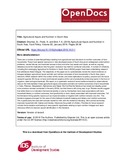| dc.contributor.author | Shankar, Bhavani | |
| dc.contributor.author | Poole, Nigel | |
| dc.contributor.author | Bird, Frances A. | |
| dc.date.accessioned | 2019-02-12T16:59:06Z | |
| dc.date.available | 2019-02-12T16:59:06Z | |
| dc.date.issued | 2019-01 | |
| dc.identifier.citation | Shankar, B.; Poole, N. and Bird, F.A. (2019) Agricultural Inputs and Nutrition in South Asia, Food Policy; Volume 82, January 2019, Pages 28-38 | en |
| dc.identifier.uri | https://opendocs.ids.ac.uk/opendocs/handle/20.500.12413/14330 | |
| dc.description.abstract | There are a number of potential pathways leading from agricultural input decisions to nutrition outcomes of farm households. These have special resonance in less developed areas of South Asia given widespread undernutrition problems, market failures and restricted access to land and other key assets and inputs, as well as ongoing debates around the implications that the green revolution has held for nutritional outcomes. A number of initiatives, including the Leveraging Agriculture for Nutrition in South Asia (LANSA) project have been undertaking research that addresses these linkages. The objectives of this paper are to systematically review the recent evidence on linkages between agricultural inputs and diet and nutrition outcomes of farm households in South Asia, place relevant LANSA research within the context of this review, and draw implications for policy, practice and the future research agenda. We focus on land and livestock assets and the set of productivity enhancing inputs in the form of irrigation, seed and agrochemicals. We report on a systematic review of recent evidence based on observational data on the links between these agricultural inputs and assets and diet and nutrition outcomes of farm households in India, Pakistan, Bangladesh, Afghanistan and Nepal. We find that the literature has slowly but steadily grown since previous reviews conducted in the early 2010s, but that there is still a long way to go. Review results suggest that while there is no indication that land ownership or size by themselves have clear associations with farm household dietary or nutrition outcomes, land productivity is more clearly associated with improved outcomes. Yet the literature linking specific inputs such as improved seeds or irrigation with nutrition remains very thin. The literature appears strongest for the case of links between livestock keeping and dietary and nutrition outcomes. This is particularly the case with animals reared for milk, with the evidence indicating milch animal ownership improves household milk intakes and thereby influences the growth of children. Priorities for future research include the formulation and testing of more specific hypotheses relating to input-nutrition linkages and more strenuous efforts to improve causal identification in this literature. | en |
| dc.language.iso | en | en |
| dc.publisher | Elsevier Ltd. | en |
| dc.relation.ispartofseries | Food Policy;Volume 82, January 2019, Pages 28-38 | |
| dc.rights.uri | http://creativecommons.org/licenses/by/4.0/ | en |
| dc.subject | Nutrition | en |
| dc.title | Agricultural Inputs and Nutrition in South Asia | en |
| dc.type | Article | en |
| dc.rights.holder | © 2018 The Authors. Published by Elsevier Ltd. | en |
| dc.identifier.externaluri | https://www.sciencedirect.com/science/article/pii/S0306919218308297 | en |
| dc.identifier.doi | 10.1016/j.foodpol.2018.10.011 | |
| dcterms.dateAccepted | 2018-10-26 | |
| rioxxterms.funder | Department for International Development, UK Government | en |
| rioxxterms.identifier.project | LANSA | en |
| rioxxterms.version | NA | en |
| rioxxterms.versionofrecord | https://doi.org/10.1016/j.foodpol.2018.10.011 | en |
| rioxxterms.funder.project | 752f8189-3789-4438-be29-585edbe66660 | en |


